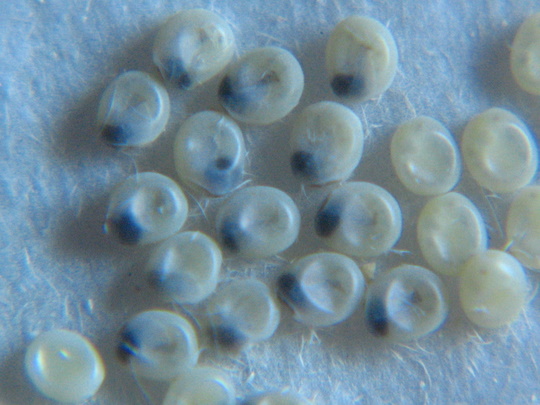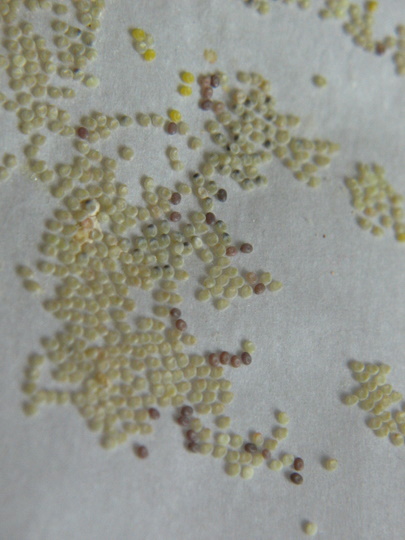Voltinism
Voltinism refers to the number of broods that a silkmoth strain (or species) will have per year. Most of the silkworm strains in cultivation are univoltine (or monovoltine) – meaning they have one brood per year, and the eggs laid by the moths of that brood will go into diapause to hatch the next year. Some strains are bivoltine, and have one generation that overwinters, and one that has non-diapausing eggs.
This strain from Thailand is multivoltine, meaning that it has multiple generations per year. This makes sense in a region that has a very mild winter, and allows rearers to take advantage of the long growing season. The first generation in spring lays eggs which hatch without diapause, and they continue to do so until the light cycle tells the worms that summer is drawing to a close, and then the moths will lay diapause eggs. Some strains never diapause, like the Cambodians – but because of that, I wasn’t able to keep up with the strain. I don’t have fresh mulberry in December.
The non-diapause eggs don’t mature the same way that diapause eggs do. Instead of turning from pale yellow to brown and then gray, they stay pale yellow. The only indication that they are fertile (and about to hatch!) is when you can see the head of the developing silkworm through the eggshell; it’s called “blue eye stage,” and it usually means you have a day or two before hatch time.
Fortunately, these moths are beginning to get the feel that summer is fading – they are laying some diapause eggs amongst the non-diapause. I think that this is actually the work of multiple moths, one laying diapause eggs and one laying non-diapause eggs, but I wasn’t segregating them and can’t be sure.
The diapause eggs are tan colored, and will shift to dark gray, indicating they’re developed and in diapause – at that point, they can be refrigerated for storage until spring.




wow that’s cool!
Y’all should come see us on Saturday – I can bring some worms you can take home! 🙂
If you know anyone who would like this kind of thing:
http://www.artandseek.org/event.php?id=11909
and the PDF with pretty pictures,
http://www.sammonsartcenter.org/PDF/The%20Culture%20of%20Cloth.pdf
wondrous.
how wondrous.
And they know, by the length of the daylight hours, and the temperature. Aren’t they smart little bugs?
nature is a wonder.
paying attention to it brings us closer.
i am grateful for you.
you have the most silky and lickable brainz =D
I love getting a chance to learn more about what you do! Too neat!
Very cool entry! Thanks for posting it.
Wow, great photos, and a very good explanation/demonstration for the inexperienced! 🙂
I watch the eggs of my second-generation moths closely. They all show signs of preparing to overwinter. At least they aren’t crazy enough to give a third generation this year.
I’m afraid they are going steadily bivoltine. I’m wondering if it’s yet another atavism, like the flying male moths. But at least this year’s second generation was much healthier than last year’s.
I know it’s at the Sammons, but what time? I’m sure Boy would be fascinated, assuming it’s after/before the other stuff we have scheduled that day. (Gearing up for school means stuffing a ton of activities into every day left of summer…apparently.) Good lord, I could use a nap. 🙂
2 PM to 5 PM. Which, I’m sure, is prime summer-Saturday real estate!
I think we’re going to give it a try, but I can’t promise anything yet. Depends on how late a bday pool party runs and if Boy is anything more than a limp sunburned noodle. 🙂
neet.
Do you still sometimes raise wild silk moths? I had a few in my apartment but I didn’t get to breed them and raise them.
yes; I actually have Polyphemus moths laying eggs right now!
oooooo. SWEET!!!!!
Do you sell or give away cocoons? I had a polyphemus moth, but I let her go as she didn’t get any mates.
Also male cynthia moths kind of smell… it’s odd.
Where can I fin the Cambodian strain.
I live in Indiana
I use chow in winter.
Unfortunately, they’re not available. You’d have to go to Cambodia.
Belissima foto!Sua irmã e linda e o seu amor com ela também! Bjos, Ju